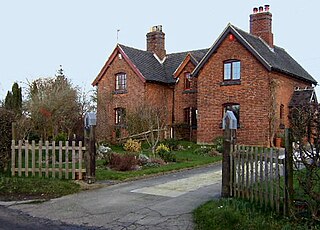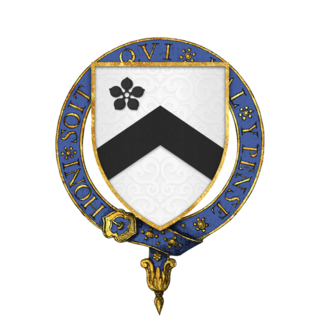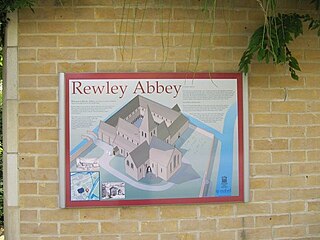
Pitchcott is a village and civil parish in the Aylesbury Vale district of Buckinghamshire, England. It is about 3 miles (5 km) northeast of Waddesdon, slightly less than 4 miles (6.4 km) south of Winslow and slightly more than 4 miles (6.4 km) north of Aylesbury. It is in the civil parish of Oving.
Thomas Charlton was Bishop of Hereford, Lord High Treasurer of England, Lord Privy Seal, and Lord Chancellor of Ireland. He is buried in Hereford Cathedral in Hereford, Herefordshire, England.

Barton Blount is a village and civil parish in the South Derbyshire district of Derbyshire, England, between Derby and Uttoxeter. According to the 2001 census it had a population of 74. The population remained at fewer than 100 for the 2011 Census. Details are included in the civil parish of Church Broughton.

Aubrey de Vere, 10th Earl of Oxford was the third son of John de Vere, 7th Earl of Oxford and Maud de Badlesmere, daughter of Bartholomew de Badlesmere, 1st Lord Badlesmere.

Eleanor de Bohun was the elder daughter and co-heiress, of Humphrey de Bohun, 7th Earl of Hereford (1341–1373), by his wife Joan Fitzalan, a daughter of Richard FitzAlan, 10th Earl of Arundel and his second wife Eleanor of Lancaster.

Hinton Admiral is the estate and ancestral home of the Tapps-Gervis-Meyrick family and located in the settlement of Hinton, near Bransgore in Hampshire, England. It is a Grade 1 Listed building.
This is a list of Sheriffs of Norfolk and Suffolk. The Sheriff is the oldest secular office under the Crown and is appointed annually by the Crown. He was originally the principal law enforcement officer in the county and presided at the Assizes and other important county meetings. After 1576 there was a separate Sheriff of Norfolk and Sheriff of Suffolk.
Ralph Ergham was the English bishop of Salisbury from 1375 to 1388, and then bishop of Bath and Wells from 1388 to 1400.

Sir Arnold Savage of Bobbing, Kent was the English Speaker of the House of Commons from 1400 to 1402 and then again from 1403 to 1404 and a Knight of the Shire of Kent who was referred to as "the great comprehensive symbol of the English people".

Sir Thomas Rempston KG ,was Constable of the Tower and an MP.
Robert Tideman was a medieval Bishop of Llandaff and Bishop of Worcester.

The Cistercian Abbey of Rewley was an Abbey in Oxford, England. It was founded in the 13th century by Edmund, 2nd Earl of Cornwall. Edmund's father, Richard, 1st Earl of Cornwall, founder of Hailes Abbey, had intended to establish a college or chantry of three secular priests to pray for his soul, but his son Edmund substituted 'six Cistercian monks, having more confidence in them.' If this was the original plan, it was soon enlarged. In 1280 he offered the general chapter of the Cistercian order to found a college (studium) for Cistercians at Oxford, and the chapter accepted the offer, and decreed that the college should have the same privileges as the college of St. Bernard at Paris, and that it should be under the Abbot of Thame, as the other was under the Abbot of Clairvaux. The following year the chapter decreed 'out of due respect to the Earl of Cornwall' that the Abbot of Thame should be empowered to appoint an Abbot of his own choice for the house of study at Oxford, and that there should be a daily memory of the late Earl of Cornwall at Mass at the college (studium) of Oxford, according as the Abbot of the place shall ordain.

Walter Blount, 1st Baron Mountjoy, KG was an English politician.

Charley Priory was a small former priory in Leicestershire, England.
Sir Walter Blount, was a soldier and supporter of John of Gaunt, Duke of Lancaster. He later supported John's son and heir Henry Bolingbroke in his bid to become King Henry IV and in later battles against his enemies. At the Battle of Shrewsbury he served as the royal standard-bearer, was mistaken for the king and killed in combat.
Sir Bernard Brocas was an English knight, landowner and administrator who was executed for his part in the Epiphany Rising.
William Haute (1390–1462), of Bishopsbourne, Kent, was an English politician.
Robert Randolph was a Priest in the Roman Catholic Church.
Sir John Cockayne was an English soldier, politician and landowner whose wealth made him a major force in the affairs of Derbyshire under the House of Lancaster. After numerous acts of criminality in concert with other Midlands landowners, he became a member of the Lancastrian affinity centred on John of Gaunt and a supporter of Henry IV. He fought in two campaigns of the Hundred Years War but his violence and lawlessness continued and he was decidedly out of favour during the reign of Henry V. With power less concentrated in the early years of Henry VI, he was able to serve three terms as High Sheriff of Nottinghamshire, Derbyshire and the Royal Forests and to wield considerable power and influence. He represented Derbyshire no less than nine times and Warwickshire twice in the House of Commons of England.
Sir Drugo Barentyn, sometimes spelled as "Drew", "Dru", "Barentine" or "Barrington", was an English goldsmith and politician who served twice as Lord Mayor of London.